
Queens is a borough of New York City, coextensive with Queens County, in the U.S. state of New York. Located on Long Island, it is the largest New York City borough by area. It is bordered by the borough of Brooklyn at the western tip of Long Island, with Nassau County to its east. Queens shares water borders with the boroughs of Manhattan, the Bronx, and Staten Island and with New Jersey.

Flushing Meadows–Corona Park, often referred to as Flushing Meadows Park, or simply Flushing Meadows, is a public park in the northern part of Queens in New York City, New York, U.S. It is bounded by I-678 on the east, Grand Central Parkway on the west, Flushing Bay on the north, and Union Turnpike on the south. Flushing Meadows–Corona Park is the fourth-largest public park in New York City, with a total area of 897 acres (363 ha).

LaGuardia Airport is a civil airport in East Elmhurst, Queens, New York City. Covering 680 acres (280 ha) as of July 1, 2023, the facility was established in 1929 and began operating as a public airport in 1939. It is named after former New York City mayor Fiorello La Guardia.

Floyd Bennett Field is an airfield in the Marine Park neighborhood of southeast Brooklyn in New York City, along the shore of Jamaica Bay. The airport originally hosted commercial and general aviation traffic before being used as a naval air station. Floyd Bennett Field is currently part of the Gateway National Recreation Area's Jamaica Bay Unit, and is managed by the National Park Service (NPS). While no longer used as an operational commercial, military, or general aviation airfield, a section is still used as a helicopter base by the New York City Police Department (NYPD), and one runway is reserved for hobbyists flying radio-controlled aircraft.

Land reclamation, usually known as reclamation, and also known as land fill, is the process of creating new land from oceans, seas, riverbeds or lake beds. The land reclaimed is known as reclamation ground,reclaimed land, or land fill.
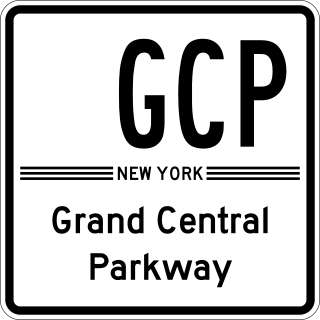
The Grand Central Parkway (GCP) is a 14.61-mile (23.51 km) long parkway that stretches from the Triborough Bridge in New York City to Nassau County on Long Island. At the Queens–Nassau border, it becomes the Northern State Parkway, which runs across the northern part of Long Island through Nassau County and into Suffolk County, where it ends in Hauppauge. The westernmost stretch also carries a short stretch of Interstate 278 (I-278). The parkway runs through Queens and passes the Cross Island Parkway, Long Island Expressway, LaGuardia Airport and Citi Field, home of the New York Mets. The parkway is designated New York State Route 907M (NY 907M), an unsigned reference route. Despite its name, the Grand Central Parkway was not named after Grand Central Terminal.

East Elmhurst is a residential neighborhood in the northwest section of the New York City borough of Queens. It is bounded to the south by Jackson Heights and Corona, to the north and east by Bowery Bay, and to the west by Woodside and Ditmars Steinway. The area also includes LaGuardia Airport, located on the shore of Flushing Bay, LaGuardia Landing Lights Fields, and Astoria Heights.
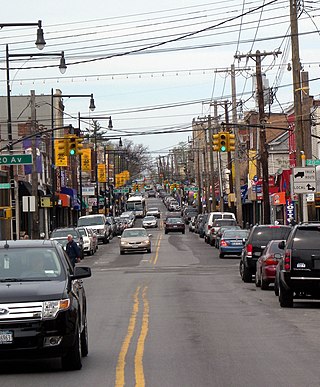
College Point is a working-middle-class neighborhood in the New York City borough of Queens. It is bounded to the south by Whitestone Expressway and Flushing; to the east by 138th Street and Malba/Whitestone; to the north by the East River; and to the west by Flushing Bay. College Point is a mostly residential ethnically diverse community with some industrial areas. The neighborhood is served by several parks and contains two yacht clubs.
The World's Fair Marina is a public marina in Flushing Bay, Queens, New York. It is located at the northern edge of Flushing Meadows–Corona Park, next to a 1.4-mile (2.3 km) long stretch of promenade around Flushing Bay, and near LaGuardia Airport and Citi Field. It is operated by the Marine Division of the Department of Parks and Recreation.

The Flushing River, also known as Flushing Creek, is a waterway that flows northward through the borough of Queens in New York City, mostly within Flushing Meadows–Corona Park, emptying into the Flushing Bay and the East River. The river runs through a valley that may have been a larger riverbed before the last Ice Age, and it divides Queens into western and eastern halves. Until the 20th century, the Flushing Creek was fed by three tributaries: Mill Creek and Kissena Creek on the eastern bank, and Horse Brook on the western bank.

Flushing Airport is a decommissioned airfield in northern Queens in New York City. It is located in the neighborhood of College Point, near Flushing. The airfield was in operation from 1929 to 1984.
Ditmars Boulevard, originally known as Ditmars Avenue, is a street located in northwest Queens, New York City. It is divided into two segments; one travels through the neighborhood of Ditmars, located within Astoria, and the other acts as a service road for the Grand Central Parkway near LaGuardia Airport in East Elmhurst.

Bowery Bay is a bay off the East River in New York City. It is located near the Ditmars Steinway area in the neighborhood of Astoria in the New York City borough of Queens. It is bordered on the west by the Bowery Bay Water Pollution Control Plant and on the south and east by LaGuardia Airport.
Hornblower Cruises & Events NOW City Experiences, more commonly known simply as Hornblower is a San Francisco-based charter yacht, dining cruise and ferry service company.

The New York metropolitan area has the busiest airport system in the United States and the second busiest in the world after London. It is also the most frequently used port of entry and departure for international flights. In 2011, more than 104 million passengers used the airports under the auspices of the Port Authority of New York and New Jersey (PANYNJ). The number increased to 117 million in 2014.
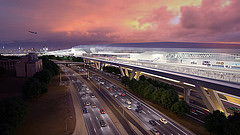
AirTrain LaGuardia was a proposed 1.5-mile-long (2.4 km) people mover system and elevated railway in New York City, United States, that would provide service to LaGuardia Airport in Queens. It would have connected with the New York City Subway and Long Island Rail Road (LIRR) in Willets Point, similar to how the existing AirTrain JFK system connects John F. Kennedy International Airport’s six terminals to the LIRR in southern Queens at Jamaica station and to the subway at both Sutphin Boulevard–Archer Avenue–JFK Airport station and Howard Beach-JFK Airport station; and how the existing AirTrain Newark station connects Newark Liberty International Airport’s three terminals to NJ Transit Rail Operations and Amtrak at a dedicated station.
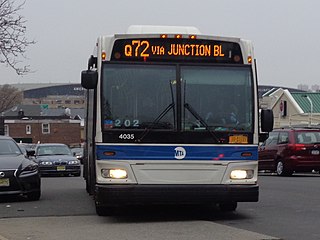
The Q72 bus route constitutes a public transit route along Junction Boulevard and 94th Street in Queens, New York City. It operates between the Rego Park and East Elmhurst neighborhoods of Queens, and extends into LaGuardia Airport at the north end of the borough. It is city-operated under the MTA Bus Company brand of MTA Regional Bus Operations.
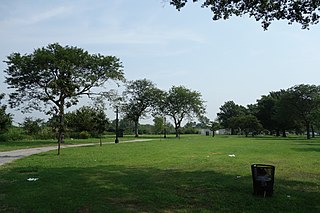
Edgemere Landfill is a former municipal landfill located in Edgemere on the Rockaway peninsula in Queens, New York City. It is located on a man-made peninsula on the Jamaica Bay shoreline, at the eastern end of the Rockaway peninsula. A portion of the site is currently open to the public as Rockaway Community Park. The entire site is owned by the New York City Department of Parks and Recreation.


















